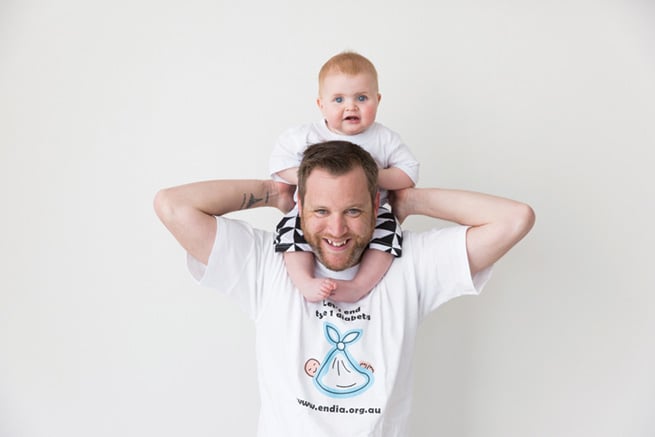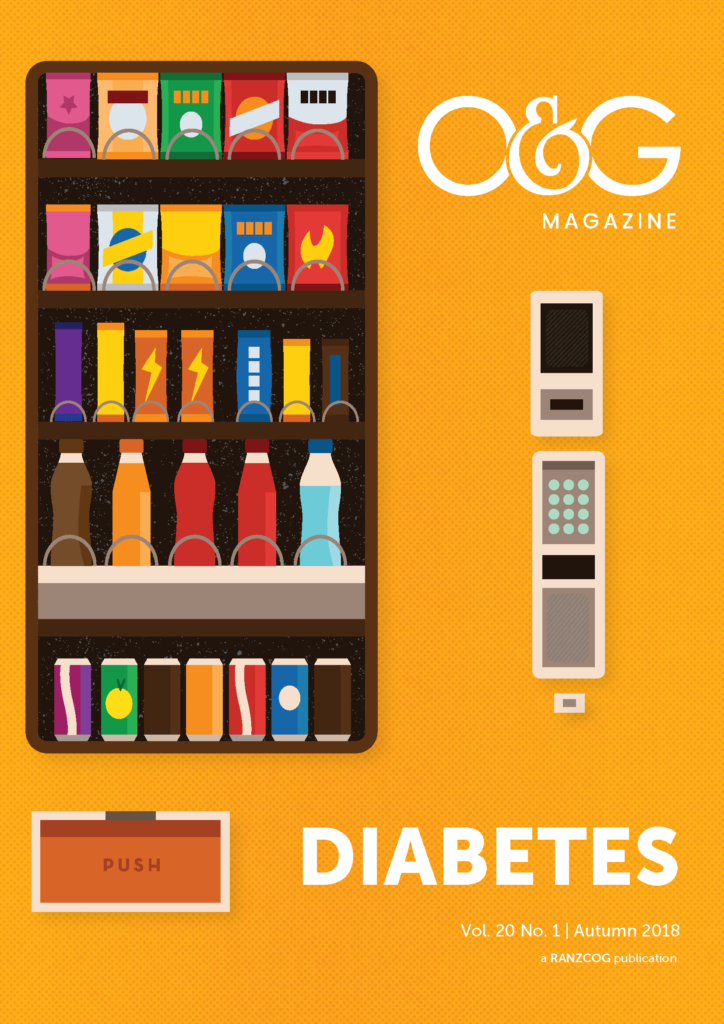The incidence of type 1 diabetes has doubled over the last 30 years in Australian children and has been increasing annually by around two to five per cent globally.1 2 3 4 5
The majority of children who present with clinical type 1 diabetes are of school age. However, 80 per cent of children who develop type 1 diabetes by 18 years of age will have islet autoantibodies present at three years of age. Islet autoantibody development is the first detectable sign that an immune attack on pancreatic beta cell has commenced, although the precipitating event that initiates and drives this attack is unknown. The evolving concept that type 1 diabetes in many children has developmental origins has directed research questions in search of prevention back to pregnancy and early life. To this end, the world’s first pregnancy to early childhood cohort study in at-risk children, the Australian Environmental Determinants of Islet Autoimmunity (ENDIA) Study, has been established in Australia.

ENDIA participants, Andy and his son, Finley (Canberra, ACT).
Type 1 diabetes can be viewed as part of the non-communicable disease epidemic in our modern society. In some countries, the fastest rate of increase has been identified in children aged five years and under.6 Two lines of evidence strongly support the role of the modern environment in the development of type 1 diabetes. First, the global increase in the incidence of type 1 diabetes, and, second, this is in parallel with a reduction in the proportion of individuals with the highest genetic risk. A striking example of the impact of the environment comes from two bordering regions (Finland and the Republic of Karelia). They share a similar genetic background, but the rates of type 1 diabetes are markedly different. Finland has the highest incidence in the world, at some 58 cases per 100,000. This is about six times higher than Karelia, where the rate is less than 10 cases per 100,000 per year.7
Stages of type 1 diabetes
Some individuals who have increased genetic risk of type 1 diabetes progress at variable rates to immune activation and islet autoantibody presentation. The development of two or more islet antibodies (now termed stage 1 type 1 diabetes) ultimately progresses to asymptomatic intermittent raised blood glucose after food (stage 2 type 1 diabetes) and then to the symptoms of ‘clinical’ type 1 diabetes (stage 3 type 1 diabetes).
Developmental origins of type 1 diabetes
If a child develops multiple islet autoantibodies by five years of age, there is virtually a 100 per cent risk of progressing to type 1 diabetes in the absence of any effective interventions.8 In at-risk children who have a family member with type 1 diabetes, islet antibodies peak from nine to 30 months of age,9 including in a previous Australian birth cohort.10 Therefore, there is a strong imperative to look back to preconception and pregnancy to consider the drivers of type 1 diabetes in childhood.
What are the modifiable exposures in early life that may be causing type 1 diabetes?
Parental age at conception, weight, nutrition, lifestyle, sleep and use of antibiotics during pregnancy and infancy have changed substantially over the last 30 years, during which time childhood type 1 diabetes has doubled in incidence in Australia. A mother’s weight and nutrition during pregnancy alter the lifetime risk of overweight issues and type 2 diabetes in her child, but there is no prospective data for type 1 diabetes. Experimental models increasingly show that the father’s weight, exercise and other environmental exposures before conception induce epigenetic changes in sperm that alter his child’s metabolic health.11
Congenital rubella is a long-standing recognised, but fortunately now rare, environmental trigger. Other putative exposures are enterovirus infections during pregnancy and childhood, and the introduction of multiple foreign antigens in the infant diet. In at-risk children, concurrent breastfeeding at the time of cereal introduction may be protective.12 Studies have found that breastfeeding and delay of the introduction of cow’s milk do not alone influence a child’s risk. Omega 3 fatty acids, which have anti-inflammatory properties, may have a small protective effect in early life.13 Vitamin D metabolism, which also modulates immune and inflammatory systems, may also play a role, particularly in some genetic subtypes.
The modern environment provides for excess nutrition in mothers during pregnancy and for rapid growth and weight gain in children in early life, with an accompanying reduction in insulin sensitivity. About 50 per cent of mothers (and fathers) are overweight or obese at conception. Rapid weight gain in early childhood may accelerate both development of islet autoimmunity and progression to type 1 diabetes. Increased childhood weight gain in the first two years has shown an increase in the risk of islet autoimmunity in Australian children.10
The ‘omes
There is heightened interest in the interaction of the environment with biological systems (including the epigenome, microbiome and metabolome). These in turn can regulate immune tolerance. A breakdown in immune tolerance and abnormal development of immune regulation in the infant, is one mechanism that is critical to the development of autoimmunity. Conception is an important time when the environment induces epigenetic changes in reproductive cells in both parents. Such epigenetic changes can influence disease development in the next and future generations. Environmental factors are likely to be interacting via ‘the ‘omes’, including the virome, to increase the penetrance of type 1 diabetes risk genes.
The microbiome has been a particular focus of research in the development of type 1 diabetes. It is acquired before and at birth and is instrumental in shaping both innate and adaptive components of the immune system. This underscores the critical importance of prospective studies from early life to understand the genesis of childhood-onset diseases such as type 1 diabetes. A few studies in the Northern Hemisphere have reported changes in the gut microbiome in children at risk of type 1 diabetes, but results are not uniform. No microorganism has been causally related to development of, or protection against, type 1 diabetes. Identifying an infant gut microbiome signature of susceptibility to, or protection against, type 1 diabetes and its environmental drivers would be enormously significant for the prediction and prevention of type 1 diabetes. The identification of specific protective bacteria would enable the design and testing of bespoke probiotics and targeted nutrition education.
The infant microbiome is influenced by a number of factors, including the mother’s microbiome, type of delivery (caesarean or vaginal), gestational age, infant feeding and interventions during and after birth, for example, administration of antibiotics. These bacteria rapidly change after birth, and for the first two years of life, as the child’s environment and nutrition expands.
Primary prevention trials
Primary prevention trials begin prior to development of islet autoimmunity, typically in young children at increased genetic risk of type 1 diabetes. Nutritional studies, as yet, have shown no benefit from delaying gluten exposure until 12 months of age. The Trial to Reduce Insulin-Dependent Diabetes Mellitus in the Genetically at Risk (TRIGR),15 involving a large cohort of at-risk infants, showed no benefit of weaning to an extensively hydrolysed milk formula on the development of islet autoantibodies or type 1 diabetes. Immune tolerance studies are investigating the effects of oral insulin to modulate the immune system in children at increased genetic risk.

ENDIA participants, Erin and her daughter, Laveena (Brisbane, QLD).
Future primary prevention targets being considered include the development of vaccines that induce immune tolerance in beta cells, a potential type 1 diabetes viral vaccine, and using microbiota and their products (pre- and/or probiotics) to induce immune-regulation in the infant.
ENDIA Study
ENDIA has been set up to explore the developmental origins of type 1 diabetes and to identify the gene-environment interactions and the mechanisms in early life that precede the development of type 1 diabetes. ENDIA is the first type 1 diabetes cohort study in the world to recruit from early pregnancy. The overarching goal is to identify what modifiable exposures in the mother (during preconception and early life), father (during preconception) and child (in early life) could guide us to primary prevention strategies.14
This national study aims to follow 1400 babies, with a first-degree relative living with type 1 diabetes, to identify the factors which protect or trigger the development of the condition.
The ENDIA Study is recruiting through 2018. Families living with type 1 diabetes, who are expecting a new baby, are sought to participate. This is a national observational study. There are no interventions and there is no impact on normal care. There is a regional program so families can participate from anywhere in Australia. For more information go to www.endia.org.au or contact [email protected].
References
- Maahs DM, West NA, Lawrence JM, Mayer-Davis EJ. Epidemiology of type 1 diabetes. Endocrinol Metab Clin North Am. 2010;39(3):481-97.
- Tamayo T, Rosenbauer J, Wild SH, Spijkerman AMW, Baan C, Forouhi NG, et al. Diabetes in Europe: An update. Diabetes research and clinical practice. 2014;103(2):206-17.
- Atkinson MA, Eisenbarth GS, Michels AW. Type 1 diabetes. Lancet. 2014;383(9911):69-82.
- (AIHW) AIoHaW. Incidence of insulin-treated diabetes in Australia 2015. Canberra, ACT, Australia: 2017. Rogers MAM, Kim C, Banerjee T, Lee JM. Fluctuations in the incidence of type 1 diabetes in the United States from 2001 to 2015: a longitudinal study. BMC Med. 2017;15(1):199.
- Rogers MAM, Kim C, Banerjee T, Lee JM. Fluctuations in the incidence of type 1 diabetes in the United States from 2001 to 2015: a longitudinal study. BMC Med. 2017;15(1):199.
- Patterson CC, Dahlquist GG, Gyurus E, Green A, Soltesz G. Incidence trends for childhood type 1 diabetes in Europe during 1989-2003 and predicted new cases 2005-20: a multicentre prospective registration study. Lancet. 2009;373(9680):2027–33.
- Vatanen T, Kostic AD, d’Hennezel E, Siljander H, Franzosa EA, Yassour M, et al. Variation in microbiome LPS immunogenicity contributes to autoimmunity in humans. Cell. 2016;165(4):842-53.
- Ziegler AG, Rewers M, Simell O, Simell T, Lempainen J, Steck A, et al. Seroconversion to multiple islet autoantibodies and risk of progression to diabetes in children. JAMA. 2013;309(23):2473-9
- Krischer JP, Lynch KF, Schatz DA, Ilonen J, Lernmark A, Hagopian WA, et al. The 6 year incidence of diabetes-associated autoantibodies in genetically at-risk children: the TEDDY study. Diabetologia. 2015;58(5):980-7.
- Couper JJ, Beresford S, Hirte C, Baghurst PA, Pollard A, Tait BD, et al. Weight gain in early life predicts risk of islet autoimmunity in children with a first-degree relative with type 1 diabetes. Diabetes Care. 2009;32(1):94-9.
- Raad G, Hazzouri M, Bottini S, Trabucchi M, Azoury J, Grandjean V. Paternal obesity: how bad is it for sperm quality and progeny health? Basic Clin Androl. 2017 2017; 27:20.
- Norris JM, Barriga K, Klingensmith G, Hoffman M, Eisenbarth GS, Erlich HA, et al. Timing of initial cereal exposure in infancy and risk of islet autoimmunity. JAMA. 2003;290(13):1713-20.
- Norris JM, Yin X, Lamb MM, Barriga K, Seifert J, Hoffman M, et al. Omega-3 polyunsaturated fatty acid intake and islet autoimmunity in children at increased risk for type 1 diabetes. JAMA. 2007;298(12):1420-8.
- Penno MA, Couper JJ, Craig ME, Colman PG, Rawlinson
WD, Cotterill AM, et al. Environmental determinants of islet autoimmunity (ENDIA): a pregnancy to early life cohort study in children at-risk of type 1 diabetes. BMC Pediatrics. 2013;13(1):124.






Leave a Reply